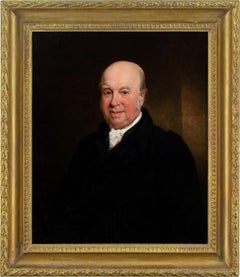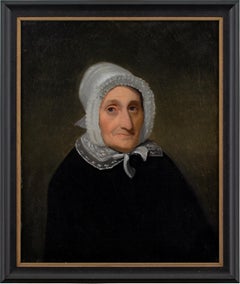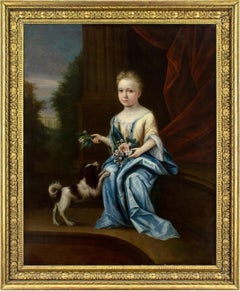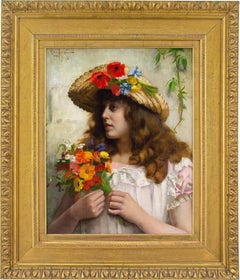Want more images or videos?
Request additional images or videos from the seller
1 of 13
UnknownLate 17th-Century Flemish School Portrait Of A Prelate With Black Cassockc. 1690
c. 1690
$3,615.30List Price
About the Item
- Creation Year:c. 1690
- Dimensions:Height: 32.5 in (82.55 cm)Width: 28.5 in (72.39 cm)
- Medium:
- Movement & Style:
- Period:1690-1699
- Condition:Assessed and approved by our conservator. Cleaned. Revarnished. Canvas relined. Fine and settled craquelure, as you would expect. The paint layer is stable. Areas of restoration. Frame restored.
- Gallery Location:Cheltenham, GB
- Reference Number:1stDibs: LU2328214729452
About the Seller
5.0
Platinum Seller
Premium sellers with a 4.7+ rating and 24-hour response times
Established in 2017
1stDibs seller since 2023
248 sales on 1stDibs
Typical response time: 2 hours
Authenticity Guarantee
In the unlikely event there’s an issue with an item’s authenticity, contact us within 1 year for a full refund. DetailsMoney-Back Guarantee
If your item is not as described, is damaged in transit, or does not arrive, contact us within 7 days for a full refund. Details24-Hour Cancellation
You have a 24-hour grace period in which to reconsider your purchase, with no questions asked.Vetted Professional Sellers
Our world-class sellers must adhere to strict standards for service and quality, maintaining the integrity of our listings.Price-Match Guarantee
If you find that a seller listed the same item for a lower price elsewhere, we’ll match it.Trusted Global Delivery
Our best-in-class carrier network provides specialized shipping options worldwide, including custom delivery.You May Also Like
INSIDE SCENE- Belgian School - Italian figurative oil on canvas painting
By Eugenio De Blasi
Located in Napoli, IT
INSIDE SCENE - Oil on canvas painting, Eugenio De Blasi, Italy, 2005
Gold leaf gilded wooden grame cm. 90X130
The painting by Eugenio De Blasi is inspired by the work of David Tenier...
Category
Early 2000s Flemish School Figurative Paintings
Materials
Canvas, Oil
$3,551
H 23.63 in W 39.38 in
18th Century Portrait Flamish School Character Oil on Canvas Black Orange White
Located in Sanremo, IT
A late 17th/early 18th century Flemish painting measuring 90 x 70 cm without frame and 100 x 80 cm with a contemporary frame.
An important characteristic of this painting is its str...
Category
Early 18th Century Flemish School Portrait Paintings
Materials
Canvas, Oil
$3,303
H 35.44 in W 27.56 in D 0.79 in
Portrait of a young man with a turban
Located in BELEYMAS, FR
Circle of Adam de Coster
(Mechelen 1586 – Antwerp 1643)
Portrait of a Young Man with a Turban, Dressed in Oriental Style
Oil on canvas
H. 43 cm ; W. 33 cm
Unsigned
This portrait of ...
Category
1620s Flemish School Portrait Paintings
Materials
Oil, Canvas
Portrait of a seated man , oil on canvas painting from the 19th century
Located in Gavere, BE
Portrait of a seated man , oil on canvas painting from the 19th century
Wonderful and large oil on canvas of a seated man, Flemish school from the end of the 19th century.
Sold with...
Category
1880s Flemish School Figurative Paintings
Materials
Gold Leaf
$12,176 Sale Price
20% Off
Free Shipping
H 42.92 in W 36.62 in D 3.94 in
After the Hunt, Jan Josef Horemans the Younger, Antwerp 1714 – 1790, Flemish
By Jan Josef Horemans the Younger
Located in Knokke, BE
After the Hunt
Jan Josef Horemans the Younger
Antwerp 1714 – 1790
Flemish School
Signature: Attributed to Jan Josef the Younger Horemans
Medium: Oil on canvas
Dimensions: Size incl...
Category
18th Century Flemish School Interior Paintings
Materials
Canvas, Oil
$8,848
H 40.16 in W 31.5 in D 1.97 in
CHERUBS - In the Manner of Rubens - Italian Oil on copper painting
By Ettore Frattini
Located in Napoli, IT
Cherubs - Ettore Frattini Italia 2006 - Oil on copper cm.30x50.
This delightful oil on copper in Baroque style depicts dancing cherubs, most likely inspired by the allegories with c...
Category
Early 2000s Flemish School Portrait Paintings
Materials
Copper
$2,477
H 11.82 in W 19.69 in
Portrait of Nicholas Poyntz
Located in London, GB
Remigius Van Leemput
Portrait of Nicholas Poyntz
1607-1675
Oil on oak panel, unsigned
Image size: 13 x 10 1/4 inches (33 x 26 cm)
Contemporary style frame
Provenance
The Dalva Brot...
Category
17th Century Flemish School Portrait Paintings
Materials
Oil, Panel
17th Century Old Head Flemish School Eyes Caravagism Oil on Canvas Yellow White
Located in Sanremo, IT
Painting oil on panel depicting a strong and distinctive old man's head with dimensions of 36 x 28 cm without frame and 68 x 60 with frame coeval Flemish school of the second half of...
Category
Late 17th Century Flemish School Portrait Paintings
Materials
Oil, Board
$4,247 Sale Price
25% Off
H 14.18 in W 11.03 in D 1.58 in
Portrait of Elegant Child in Gilded Frame Napoleon III Era Signed
Located in Pistoia, IT
"Portrait of elegant little girl" , extraordinary oil painting on wood panel signed and dated at upper left "A. Robert 1879" for Alexandre Robert.
A Belgian painter of great talent...
Category
1870s Flemish School Portrait Paintings
Materials
Oil, Wood Panel
$5,663
H 26.78 in W 23.43 in
After a Good Hunt, Petrus Kremer, Antwerp 1801 – 1888, Belgian Painter, Signed
Located in Knokke, BE
After a Good Hunt
Kremer Petrus
Antwerp 1801 – 1888
Belgian Painter
Signature: Signed bottom left
Dimensions: Image size 49,50 x 44 cm, frame size 63,50 x 58,50 cm
Medium: Oil on panel
Biography: Kremer Petrus was born on May 9 in 1801 in Antwerp. He was a Belgian painter of genre scenes with religious and historic context, still lifes and portraits.
He studied at the Antwerp Academy of Fine Art, with master teachers and artists Guillaume Herreyns (1743 – 1827) and Mattheus van Bree (1773 – 1839). He perfected himself in Paris, travelled in 1838 Germany, France and Italy where he studied in the museums the pictures of the Dutch and Flemish masters.
He excelled in the representation of flowers, poultry and game. Some of his paintings were engraved by English engraver Joseph Brown (1809 – 1887) and other artists.
Belgian painter Gustaaf Wappers (1803 – 1874) painted his portrait.
Kremer was honoured with several medals at various exhibitions, notably in London in 1929. He exhibited at the Brussels National Exhibition of 1842 “Examination of Don Carlos...
Category
19th Century Flemish School Portrait Paintings
Materials
Oil, Panel
$8,848
H 25.2 in W 23.23 in D 2.76 in
More From This Seller
View AllEarly 19th-Century English School Portrait Of Samuel Jones Of Skeyton, Norfolk
Located in Cheltenham, GB
This fine early 19th-century English oil painting depicts Samuel Jones of Skeyton, Norfolk, smartly attired in a black coat with white cravat. The portrait was previously in the coll...
Category
1830s Portrait Paintings
Materials
Canvas, Oil
Mid-19th-Century French School, A Pair Of Nanas, 2 x Oil Paintings
Located in Cheltenham, GB
This charming pair of mid-19th-century French School portraits depicts two grandmothers, both presumably widows, wearing black gowns and white bonnets.
Alas, the identity of these r...
Category
Mid-19th Century Portrait Paintings
Materials
Oil, Canvas
John Verelst (Circle), Portrait Of A Young Lady With A Spaniel
By John Verelst
Located in Cheltenham, GB
This large early 18th-century full-length portrait depicts a seated young lady before a classical column and distant country house. It was formerly in the collection of Dalham Hall i...
Category
Early 18th Century Rococo Portrait Paintings
Materials
Canvas, Oil
Rowland Holyoake, Portrait Of A Girl With Wildflowers
Located in Cheltenham, GB
This charming late 19th-century oil painting by British artist Rowland Holyoake (1861-1928) depicts a girl carrying wildflowers while wearing a straw hat decorated with the same. It ...
Category
1880s Pre-Raphaelite Portrait Paintings
Materials
Canvas, Oil
Early-18th Century French School, Ex-Voto Portrait With Emilian Jacobin
Located in Cheltenham, GB
This splendid early 18th-century French oil painting represents an ‘ex-voto’ with Emilian Jacobin and a depiction of the Virgin Mary with Christ and angels.
Ex votos are votive offe...
Category
1710s French School Portrait Paintings
Materials
Oil, Canvas
Thomas Gainsborough (Follower), Portrait Of Miss Sparrow
By Thomas Gainsborough
Located in Cheltenham, GB
This exceedingly charming early 19th-century half-length portrait by a follower of Thomas Gainsborough RA FRSA (1727-1788) depicts a lady traditionally identified as ‘Miss Sparrow’. ...
Category
1830s Portrait Paintings
Materials
Canvas, Oil
Recently Viewed
View AllMore Ways To Browse
17th Century Flemish School
Portrait Of Bishop
Picasso Original Oil
Andras David
Aristocratic Portrait Paintings
Full Length Portrait Painting
Kate Moss Painting
Powdered Wigs
Warhol Studio 54
Woman Smoking Art
1800 Oil Painting Portrait
Abe Lincoln
Hollis Dunlap
Indian Girl
John Winston
Oil Painting Of King George V
Oil Portraits Of Fisherman
Pompeo Batoni



